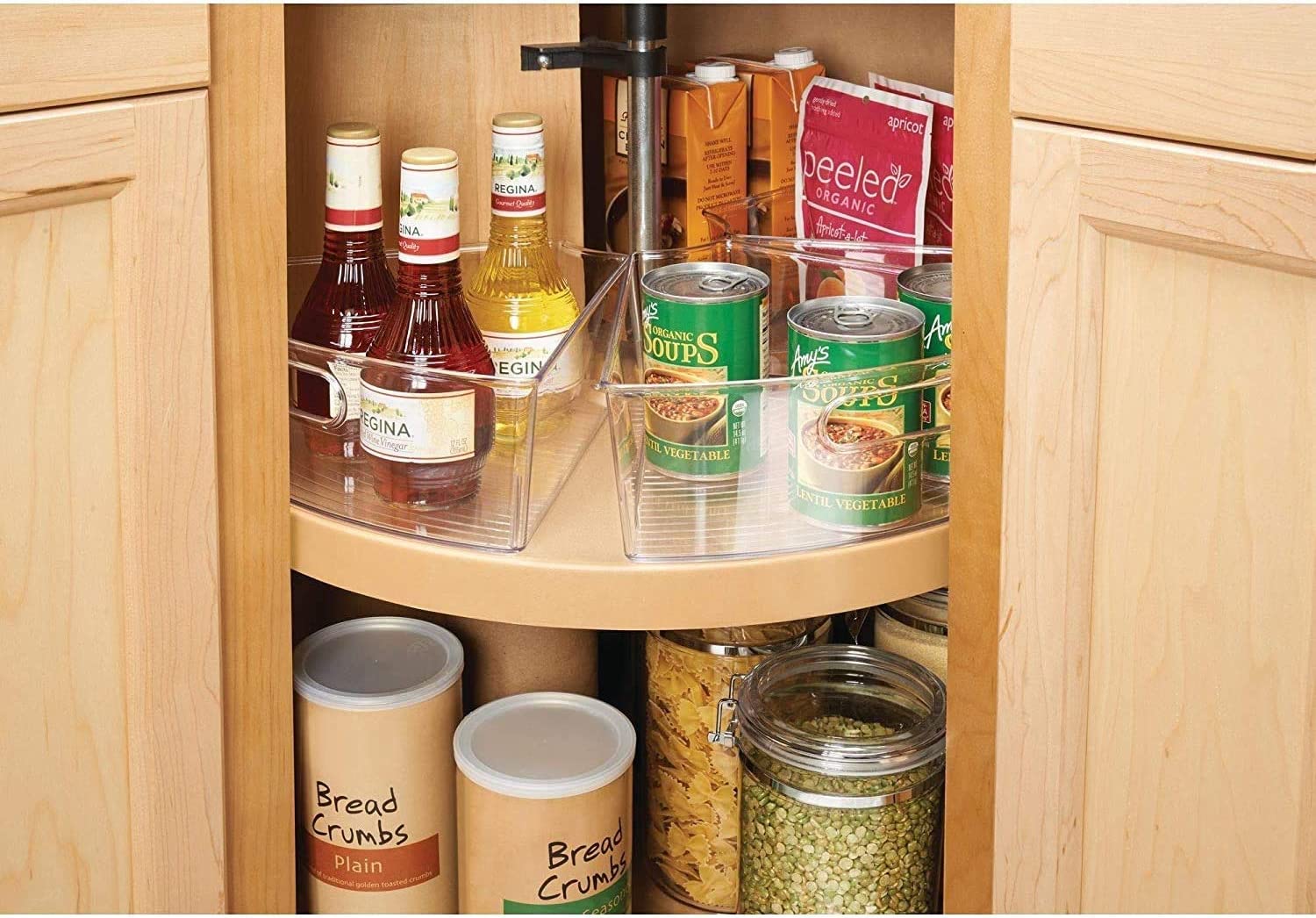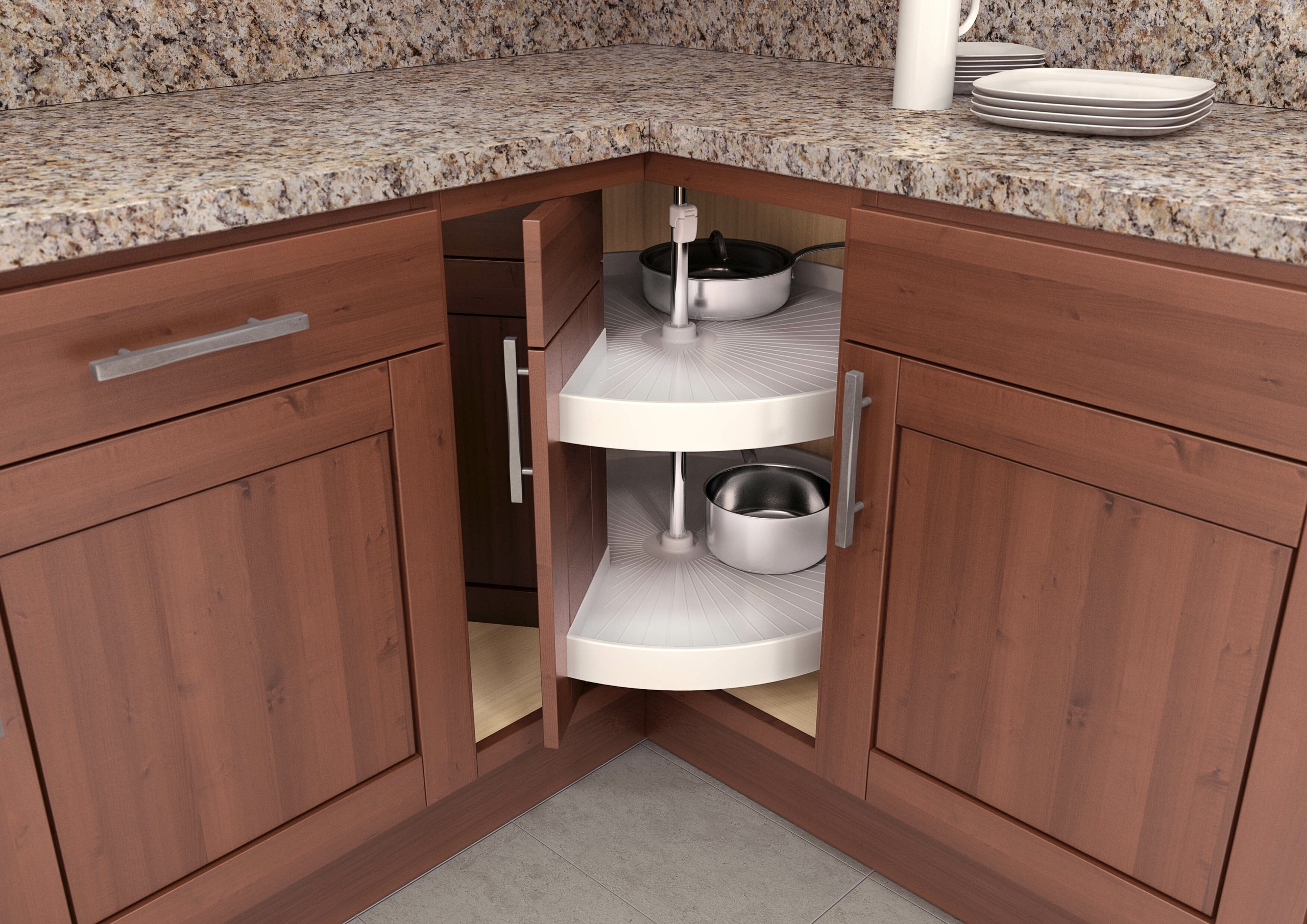Types and Designs of Cabinet Door Lazy Susans: Lazy Susan Attached To Cabinet Door

Choosing the right Lazy Susan for your cabinet can significantly improve kitchen organization and accessibility. Several factors influence this decision, including the available space, the type of items to be stored, and personal aesthetic preferences. Understanding the different materials, designs, and installation methods will help you make an informed choice.
Materials Used in Lazy Susan Construction
Lazy Susans are constructed from a variety of materials, each offering a unique balance of durability, aesthetics, and cost. Wood Lazy Susans often provide a classic and elegant look, seamlessly integrating with traditional kitchen designs. However, wood requires more careful maintenance to prevent water damage and warping. Metal Lazy Susans, typically made from steel or aluminum, offer superior durability and resistance to moisture, making them a practical choice for high-traffic areas. They can be finished in various ways to match different styles, from sleek brushed steel to antique-looking finishes. Plastic Lazy Susans are the most affordable option and are lightweight and easy to clean. However, they may not be as durable as wood or metal and can be prone to scratches and discoloration over time.
Lazy Susan Designs for Cabinet Doors
The design of your Lazy Susan will depend on the size and shape of your cabinet and your storage needs. Single-tier Lazy Susans are the simplest design, ideal for smaller cabinets or for storing items of similar size and shape. They are easy to install and relatively inexpensive. Double-tier Lazy Susans maximize storage space by offering two rotating levels. This design is particularly useful for storing a variety of items, allowing for better organization and efficient use of vertical space. However, they are generally more expensive and require more careful installation to ensure smooth rotation. Corner Lazy Susans are specifically designed to fit into corner cabinets, utilizing otherwise wasted space. They are usually more complex to install and can be more expensive than other designs. The choice between single, double, or corner units depends on the available space and the desired storage capacity.
Lazy Susan Installation Methods
Several methods exist for installing Lazy Susans in cabinet doors, each with varying levels of difficulty. The most common methods include using pre-drilled mounting holes, using a template to mark drilling locations, or utilizing a custom-built frame. Each method requires different tools and skills.
| Installation Method | Tools Required | Skill Level | Time Required |
|---|---|---|---|
| Pre-drilled Mounting Holes | Screwdriver | Beginner | 15-30 minutes |
| Template-Based Installation | Drill, Screwdriver, Measuring Tape, Pencil | Intermediate | 30-60 minutes |
| Custom-Built Frame Installation | Drill, Saw, Screwdriver, Measuring Tape, Wood/Metalworking Skills | Advanced | 1-2 hours |
Functionality and Space Optimization with Lazy Susans
Lazy Susans represent a significant advancement in kitchen cabinet organization, offering a compelling solution to the age-old problem of inaccessible items lurking at the back of deep cupboards. Their rotating functionality transforms frustratingly unreachable spaces into easily managed storage areas, maximizing both accessibility and space utilization. This translates to less wasted space, less frustration, and ultimately, a more efficient and enjoyable cooking experience.
Lazy Susans dramatically improve accessibility by bringing items from the back of a cabinet to the front with a simple rotation. This is particularly beneficial for storing heavy or bulky items like canned goods, spices, or cookware, eliminating the need to rummage through the cabinet and potentially damaging its contents. Imagine the ease of accessing those rarely-used baking pans or the back-of-the-shelf spices – a Lazy Susan makes this effortless. This improved access also promotes better inventory management, allowing you to easily see what you have and what needs to be replenished.
Lazy Susan Size and Storage Capacity
The size of a Lazy Susan directly correlates to its storage capacity. A larger Lazy Susan will naturally hold more items, but it also requires a larger cabinet. Selecting the appropriate size is crucial for optimal functionality. Improper sizing can lead to either wasted space (too small) or difficulty rotating (too large for the cabinet).
- For cabinets with a diameter of 12-15 inches, a 12-inch Lazy Susan is generally suitable.
- Cabinets with a diameter of 18-24 inches are well-suited to a 18-inch Lazy Susan.
- For larger cabinets (24-30 inches), a 24-inch Lazy Susan offers substantial storage, but careful consideration of cabinet depth and door clearance is essential.
- Corner cabinets often benefit from a double-decker Lazy Susan, maximizing vertical space and accommodating a wide variety of items.
Lazy Susan Design and Functionality, Lazy susan attached to cabinet door
The design elements of a Lazy Susan significantly impact its overall functionality. Several key features contribute to its effectiveness.
Bearing type is a critical factor influencing rotation smoothness and durability. High-quality ball bearing systems provide smoother, quieter rotation and a longer lifespan compared to simpler designs. A smooth rotation is crucial for easy access and prevents jarring movements that could damage the contents or the Lazy Susan itself. The load capacity, often specified by the manufacturer, indicates the maximum weight the Lazy Susan can safely hold. Overloading can lead to malfunctions or even breakage. Finally, the material used in construction also affects durability and resistance to wear and tear. A sturdy, well-constructed Lazy Susan will provide years of reliable service.
DIY and Customization Options for Cabinet Door Lazy Susans

Building your own cabinet door Lazy Susan offers a rewarding experience, allowing for complete control over design, size, and materials. This empowers you to create a truly bespoke solution perfectly tailored to your kitchen’s style and storage needs. The following steps provide a pathway to successful DIY Lazy Susan construction and customization.
Building a Custom Lazy Susan from Scratch
Constructing a Lazy Susan from scratch requires careful planning and execution. First, accurate measurements of your cabinet door opening are crucial. These measurements dictate the size of the Lazy Susan base and turntable. For example, a standard cabinet door might measure 12 inches wide and 12 inches deep. This would necessitate a Lazy Susan with a slightly smaller diameter to allow for smooth rotation and clearance. Consider using ¾ inch thick plywood for the base and turntable for strength and stability. For a 12-inch cabinet opening, a 10-inch diameter Lazy Susan base and turntable would be appropriate.
The materials needed include plywood, wood glue, wood screws, hinges, a dowel (for the central rotating post), and varnish or paint for finishing. Tools include a circular saw, drill, screwdriver, measuring tape, sandpaper, and clamps. The assembly involves cutting the plywood circles for the base and turntable, drilling a central hole for the dowel, attaching the hinges, and securely attaching the turntable to the base via the dowel. Once assembled, sanding and finishing will ensure a smooth, durable Lazy Susan. Consider applying multiple coats of varnish or paint for lasting protection and an aesthetically pleasing finish.
Modifying an Existing Lazy Susan
Adapting an existing Lazy Susan to fit a specific cabinet door often involves adjustments to the Lazy Susan’s size or the cabinet door itself. For example, if the existing Lazy Susan is too large, careful trimming with a circular saw and fine sanding can achieve the desired fit. Ensure to maintain the structural integrity of the Lazy Susan during the modification process. Conversely, if the Lazy Susan is too small, consider adding decorative trim to increase its size and enhance its visual appeal. This can be achieved by carefully measuring and attaching strips of wood around the Lazy Susan’s perimeter. Adjusting the hinges might also be necessary to ensure proper alignment and smooth rotation within the cabinet door. Remember to test the rotation frequently throughout the modification process.
Three Unique Lazy Susan Designs
Three distinct Lazy Susan designs, each reflecting a different aesthetic, are presented below.
Modern Lazy Susan Design
This design emphasizes clean lines and minimalist aesthetics. A high-gloss white laminate would serve as the primary material, complemented by brushed stainless steel hinges and a central support post. The overall effect is sleek and contemporary, ideal for modern kitchen designs. Measurements would be tailored to the specific cabinet door, maintaining the clean, uncluttered look.
Rustic Lazy Susan Design
This design incorporates natural materials and a distressed finish for a rustic charm. Reclaimed wood, possibly with a slightly uneven surface, would be the base material. The hinges and central post could be made of dark metal with a slightly aged look. A dark walnut stain would complement the wood grain, enhancing the rustic appeal. Measurements would be chosen to complement the style, potentially using slightly irregular shapes to enhance the rustic feel.
Traditional Lazy Susan Design
This design uses classic materials and detailing to create an elegant look. A rich mahogany veneer would provide a luxurious feel, complemented by ornate brass hinges and a central post with decorative detailing. A polished finish would enhance the elegance, ensuring a smooth, luxurious feel. Measurements would be chosen to create a visually balanced design that complements traditional cabinetry.
